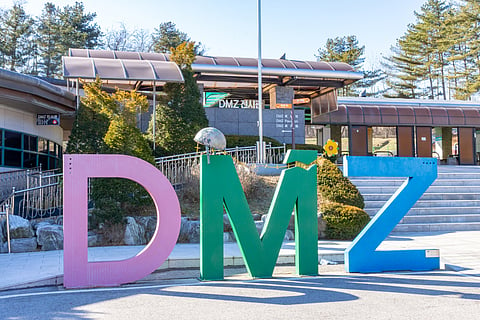
- Destinations
- Experiences
- Stay
- What's new
- Celebrating People
- Responsible Tourism
- CampaignsCampaigns
- SubscribeSubscribe
- Buy Now

It really hits you when you read a signboard that says "This area is an unconfirmed mine-detached region where a person could get killed instantly."
The words "get killed" are in red font in case the message wasn't clear enough. Obviously, the soldiers will not let you step out of the bus either but your imagination immediately transforms the forested surroundings into a pit of lava. Or worse, what it actually is—one of the many strips of land surrounding the Korean Demilitarised Zone (DMZ) which is sowed with active landmines. (Though, lately, there have been consolidated efforts to their removal.)
However, my description is a disservice to the place. Sure, it is shrouded by the obvious drama associated with the 4 km-wide and 250 km-long buffer zone that has been a major focus of geopolitics since the 1950s, but most of it is in our heads. When I was there I saw uncountable tourist groups, military buses (with soldiers on the lookout) to ferry us from tourist attraction to tourist attraction, and certainly no risk of being blown to pieces by a concealed explosive device.
And boy was I thrilled to be there. Skirting the infamous borders that separate North Korea from South Korea, the arena has seen plenty of skirmishes and inspiring stories of defection. The excitement peaked when I reached the entry point to the Third Tunnel of Aggression after a military bus ride from the tourist parking lot.
Back in 1978, the North Koreans began digging a tunnel 1.2 km from the Military Demarcation Line (the MDL lies in the centre of the DMZ) till it breached the border. They continued to dig a further 435 m into South Korea. With a depth of just 73 m below the surface, this was the third such incursion tunnel. Luckily, it was intercepted in time. A small train allows visitors access to this tunnel.
Once I was seated and buckled up, the locomotive slowly made its way down a shaft. Since I faced the opening, I watched the sunlight disappear and the tunnel lights take its place. The temperature fell steadily, feeling like the sudden arrival of winter, but soon enough I was at the mouth of the arched tunnel that led to the MDL. Wearing a yellow helmet I made my way across the two-metre-tall passage. About 235 m in, I arrived at a wall with a glass window that gave me a view of the tunnel that lay beyond. I was still 200 m from the line so while I cannot say I'd stepped onto North Korean territory, I did come within striking distance of a passage that could have allowed 30,000 enemy soldiers to pass through within an hour had it not been discovered.
Back on the surface, I made my way to the Dora Observatory. Named after the mountain on which it is situated (Mount Dora), it literally gave me a glimpse of North Korea. I may have had to rely on my imagination for the tunnel but the observatory was a flat out revelation. Kijong-dong is the North Korean 'peace village' and lies below the hill at a distance. It's a cityscape that seemed motionless except for the flights of birds. Even now North Korea could not shake off its enigma; the village seemed desolate and reminded me of the South Korean claim that this was an uninhabited 'propaganda village', meant to attract defectors and give a sense of grandeur through low- and high-rise buildings, colourful rooftops, towers and other appealing elements. Whether it was a Potemkin village or not, I was certainly charmed. Clearly, this was effective propaganda.
My final DMZ experience also turned out to be my favourite. It was a visit to Dorasan Station which opened in 2002 after the North-South Joint Declaration of 2000. This agreement meant to connect both Koreas by railroad. Neat, modern and dubbed as "not the last station from the South but the first station towards the North," I bought plenty of souvenirs from here: tickets and KORAIL stamps which mentioned the station's distance from Pyongyang (the North Korean capital, 205 km away) and Seoul (56 km away). I also bought one of the 150,625 pieces of barbed wire removed from the DMZ fence in 2000 as a memento of peace.
Indeed, what I loved the most about the place was this call to peace, best reflected in a message displayed at the station: "When the Trans-Korea Railway (TKR), the Trans-Siberia Railway (TSR) and the Trans-China Railway (TCR) are connected in the future, Dorasan Station promises to emerge as the starting point of the transcontinental railroad."
And a new chapter in history too, I am sure.
